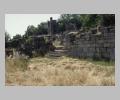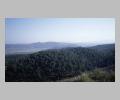
Drainage under the stadium, Labraunda.
| Summary: | A major religious sanctuary and refuge in the Carian territory of Mylasa. |
| Type: | Sanctuary |
| Region: | Caria |
Periods:
Archaic
Classical
Hellenistic
Roman
Byzantine
Physical:
The site occupies a series of artificial terraces 600 meters above sea level on the S slope of a mountain overlooking the plain of Milas. It is linked by a 7.5 m wide, paved Sacred Way to the city of Mylasa (modern Milas), 13 km to the S. The artificial terraces at Labraunda, connected by ramps and stairways, extend from the propylaeae and courtyard at the SE corner of the site to just below the summit of the mountain. The building remains (dating chiefly to the 5th century B.C. and 1st century A.D.) include the temple of Zeus, 3 androns or male club buildings, 2 stoas, 2 Roman baths, several priests' residences, a nymphaium or well-house, and possibly a treasury. Remains to the SE may be the fountain and pool for bejeweled, tame fish reportedly maintained at the sanctuary, possibly in connection with an oracle. Above the main sanctuary are the remains of a stadium, and a fortified refuge occupies the summit. Around the area of the sanctuary and along the 13 km long Sacred Way are many tombs and sepulchral monuments.
Description:
Labraunda was a major sanctuary of the Carians, dedicated to Zeus Stratius or Zeus Labraundos. The original site of the 7th century B.C. may have been simply a sacred grove of plane trees. In the 5th century B.C. the Hecatomnids, Mausolus followed by his brother Idrieus, adopted the cult and brought about a great embellishment of the sanctuary, including the erection of the 1st temple of Zeus, the Propylaeae and other major buildings. Although the sanctuary was in the territory of Mausolus' capital city of Mylasa, it enjoyed a measure of independence and its priests were responsible for the administration of the temple lands.
After the Hectomnid transformation of the sanctuary, which may have included the addition of a royal summer residence on the site and the fortified refuge above the sacred precinct, there was almost no change to the sanctuary until the 1st century A.D. when a number of buildings, including the W stoa, the well-house and 2 baths, were added. In the 4th century A.D. much of the W part of the sanctuary was destroyed by fire, but the site continued to be occupied and an early Byzantine church was built of reused material at the E end of the site. The church was destroyed by fire in the 11th century A.D.
Exploration:
Swedish excavations since 1948. Director Axel Persson of Uppsala University.
Sources Used:
Other Bibliography:




